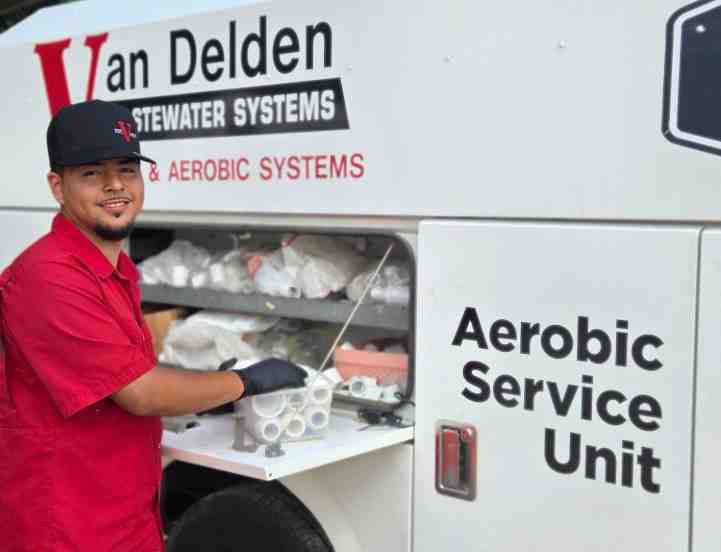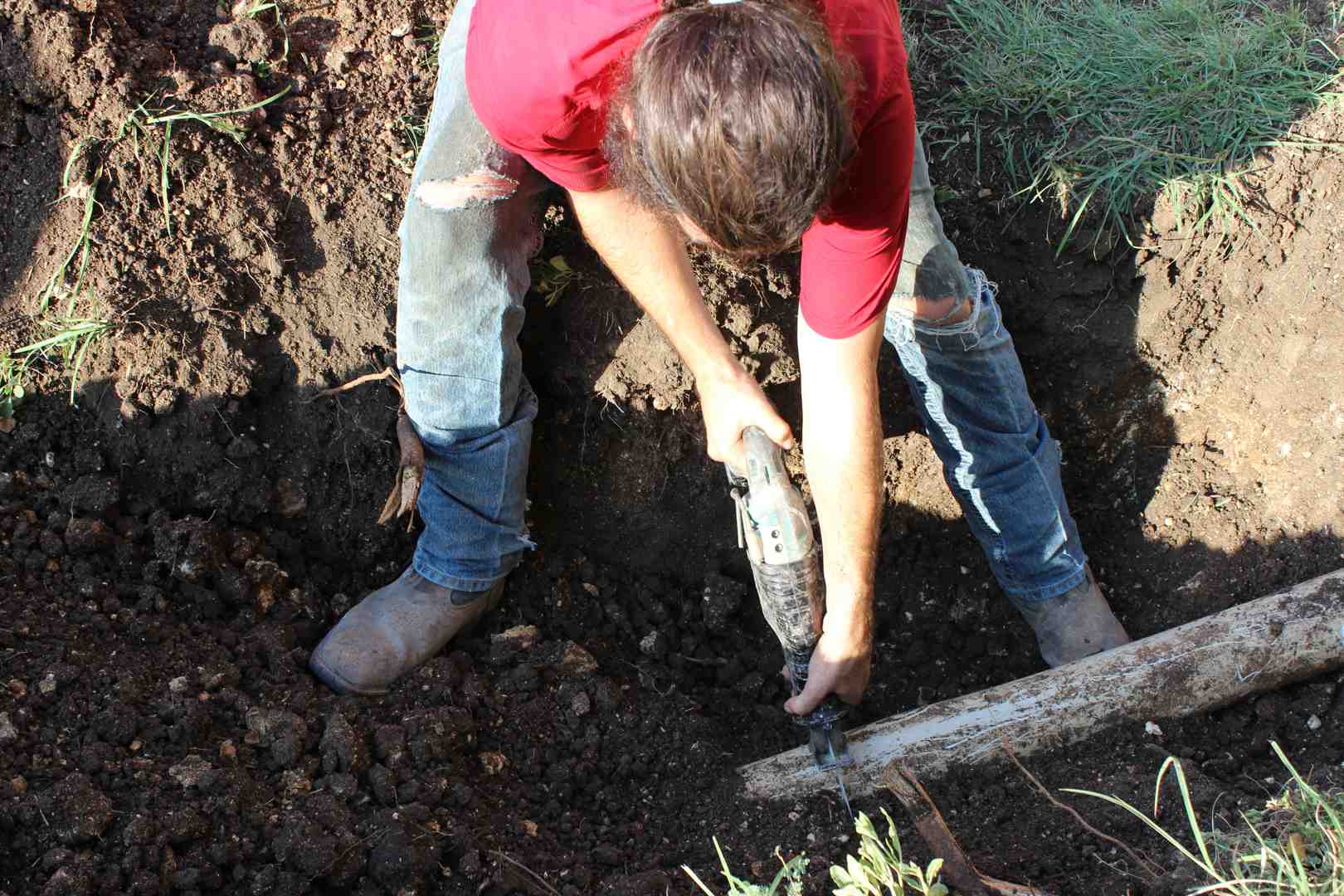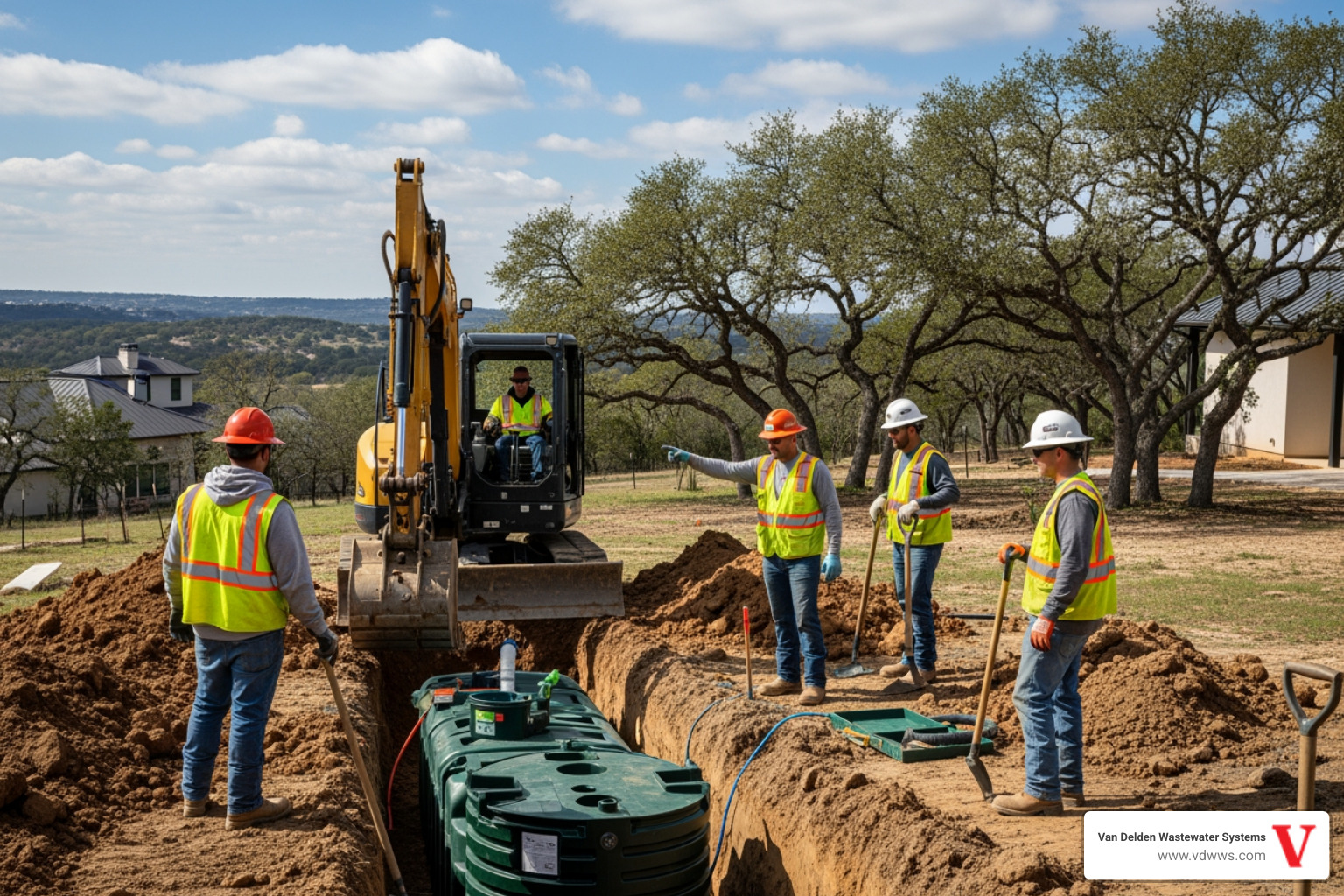Why Septic System Field Lines Are Critical for Your Home's Wastewater Treatment
Septic system field lines are the underground network of perforated pipes that distribute treated wastewater from your septic tank into the surrounding soil for final filtration and disposal. Also known as leach lines or drain fields, these components are essential for protecting your home, health, and environment.
Quick Facts About Septic Field Lines:
- Purpose: Final stage of wastewater treatment and disposal
- Function: Distribute effluent evenly into soil for natural filtration
- Components: Perforated pipes, gravel beds, and distribution systems
- Lifespan: 15-40 years with proper maintenance
- Coverage: Handle all household wastewater after septic tank treatment
The field lines are where the magic happens—they're responsible for the final 50-70% of your wastewater treatment. When they fail, you'll notice soggy spots in your yard, sewage odors, or slow-draining fixtures. These problems can lead to expensive repairs and health hazards if not addressed quickly. Understanding how your field lines work helps you maintain them properly and spot problems early, which can save you thousands of dollars.
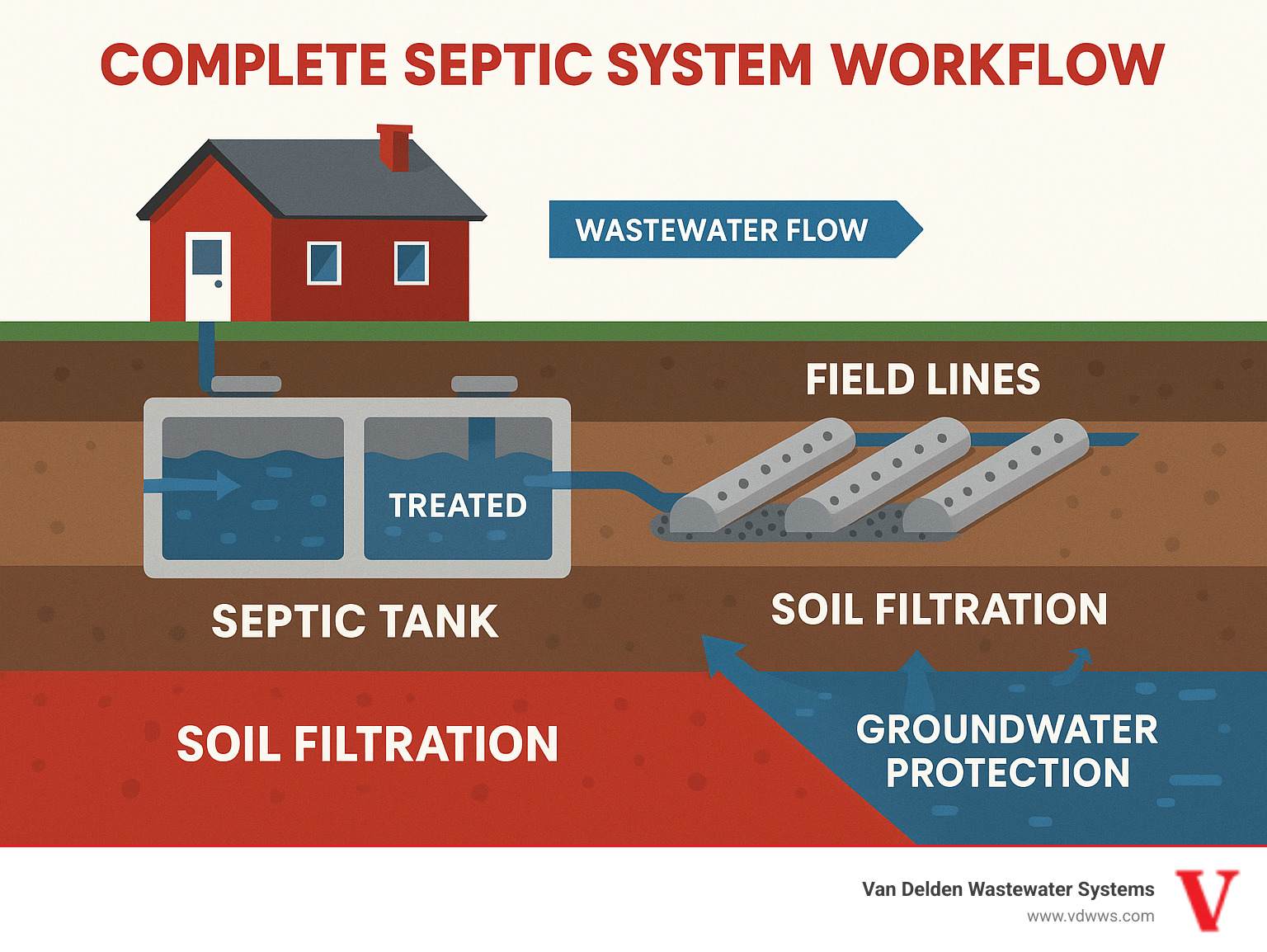
What Are Septic Field Lines and What is Their Purpose?
Septic system field lines—also called leach lines or drain fields—are networks of perforated pipes that take partially treated wastewater (effluent) from your septic tank and distribute it into the soil. The soil acts as a natural filter, where microorganisms break down remaining contaminants. This process cleans the water before it returns to the groundwater, contributing to natural groundwater recharge. You can see examples of different septic drain fields to understand their various layouts.
The Role of Field Lines in the Septic System
Wastewater first enters the septic tank, where heavy solids sink to form sludge and lighter grease floats to form scum. Bacteria in the tank perform anaerobic digestion, breaking down organic matter. The remaining liquid effluent then flows to the field lines for final treatment. The effluent is sent to a distribution box, which ensures it's spread evenly across the entire drain field. A thin biological layer called a biomat forms where the effluent meets the soil. A balanced biomat is crucial for treatment, but if it gets too thick, it can cause clogging. Our guide on Understanding Drainfield Biomat Formation explains this in more detail.
Key Components of a Drainfield
A drainfield consists of several key components working together.
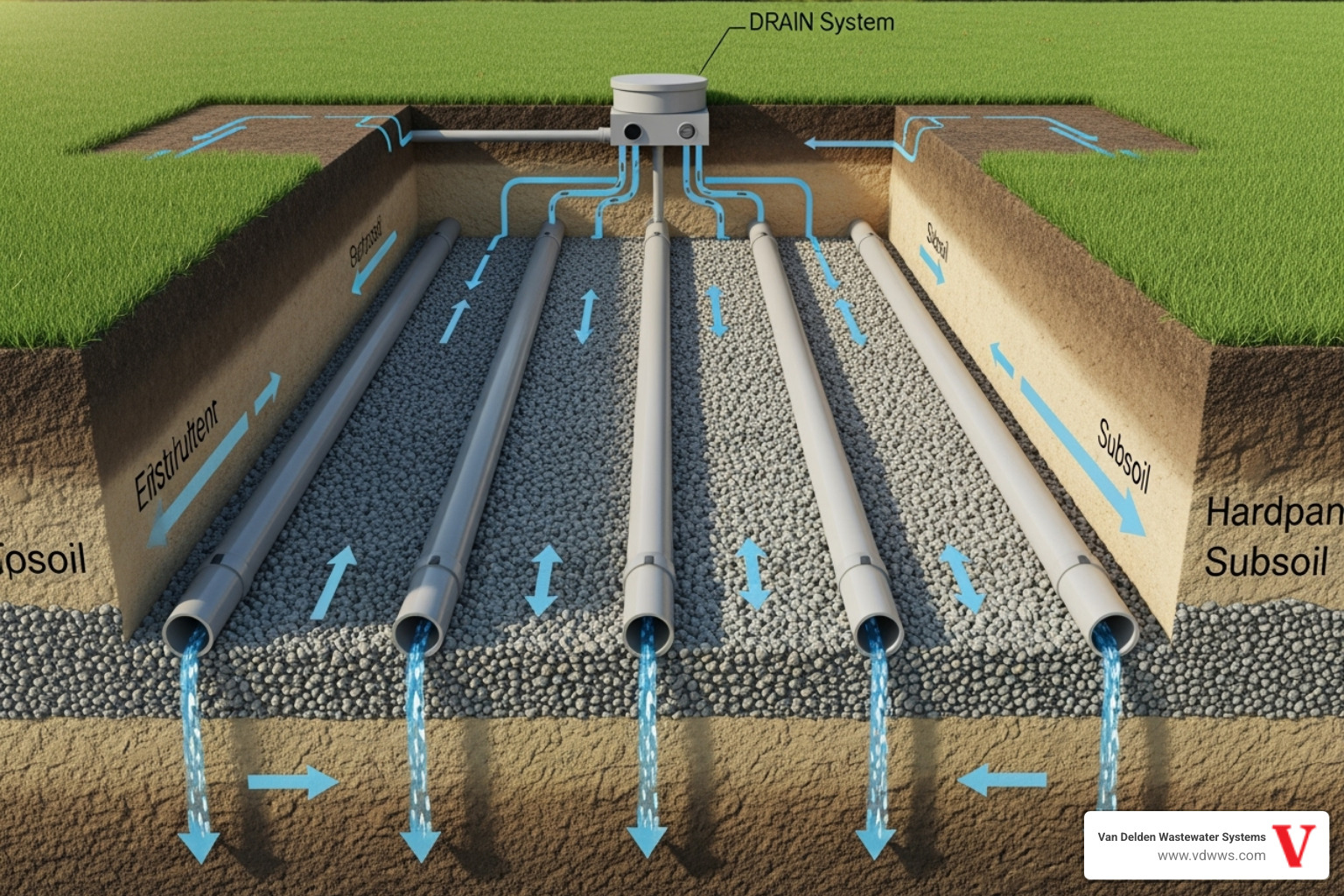
- Perforated pipes: These PVC pipes have small holes that allow effluent to seep out slowly into the surrounding gravel.
- Gravel beds: This layer surrounds the pipes, providing a stable base and helping to distribute the wastewater evenly before it reaches the soil.
- Geotextile fabric: Placed over the gravel, this fabric prevents soil from clogging the system while allowing water to pass through.
- Soil layer: The top layer of soil protects the system and supports vegetation, which can help absorb moisture and nutrients.
- Distribution box: This box connects the septic tank to the field lines, ensuring each line receives an equal amount of effluent to prevent overloading.
How Do Leach Lines Work? The Science of Wastewater Treatment
Your septic system field lines use the earth's natural cleaning power to treat wastewater. After leaving the septic tank, effluent flows to a distribution box and then into the perforated pipes of the drain field, often relying on gravity. The liquid seeps through the pipe's holes into a gravel bed and then into the surrounding soil. The soil acts as a living filter, cleaning the water through several processes:
- Physical filtration: The soil traps suspended particles.
- Biological treatment: Beneficial soil microorganisms consume organic matter and contaminants.
- Pathogen removal: Harmful bacteria and viruses are filtered out and destroyed by the soil's environment.
- Nutrient breakdown: Nitrogen and phosphorus are absorbed by plant roots or transformed by microbes.
By the time the water reaches the groundwater table, it has been naturally purified. Michigan State University offers more information on how soil treats wastewater.
The Importance of Soil and Percolation
The success of septic system field lines depends on the soil. Before installation, a percolation test ("perc test") is performed to measure how quickly water drains through the soil. This determines the necessary size of the drain field.
- Sandy soils drain quickly, which may not allow enough time for full treatment.
- Clay soils filter well but drain slowly, requiring a larger drain field.
- Loamy soils are often ideal, balancing good drainage with effective filtration.
The goal is to match the hydraulic load (daily wastewater volume) with the soil's absorption capacity. At Van Delden Wastewater Systems, we have designed systems for all Texas soil types since 1937. We also consider site-specific challenges, as detailed in our guide on Managing Drainfield Slopes and Grades.
What is a Biomat and is it Good or Bad?
A biomat is a slimy, microbial layer that forms where effluent enters the soil. This biofilm is a natural and essential part of the treatment process, as it is highly effective at breaking down contaminants.
However, a biomat can become a problem if it grows too thick. This condition, known as "bioclogging," can prevent water from percolating into the soil, leading to system backups and failure. Bioclogging can be caused by excessive solids from an unpumped tank, grease, or harsh chemicals. Maintaining a healthy, balanced biomat is key. If you suspect issues, professional diagnosis is essential, as symptoms can mimic other problems. Learn more in our guide on How to Diagnose and Fix Drainfield Failures.
Types of Drainfield Systems and Designs
When it comes to septic system field lines, there is no one-size-fits-all solution. The best design depends on your property's specific conditions, including lot size, soil depth, groundwater levels, and slope. At Van Delden Wastewater Systems, we have been designing custom systems to meet these challenges since 1937. The EPA's guide on different types of septic systems covers a wide range of options, but understanding potential issues is also important. Read about the 4 Common Causes of Septic Drainfield Failure to help you make informed decisions.
Conventional Drainfield Systems
The conventional drain field is the most common type of system. It is a reliable and effective design when site conditions are suitable.
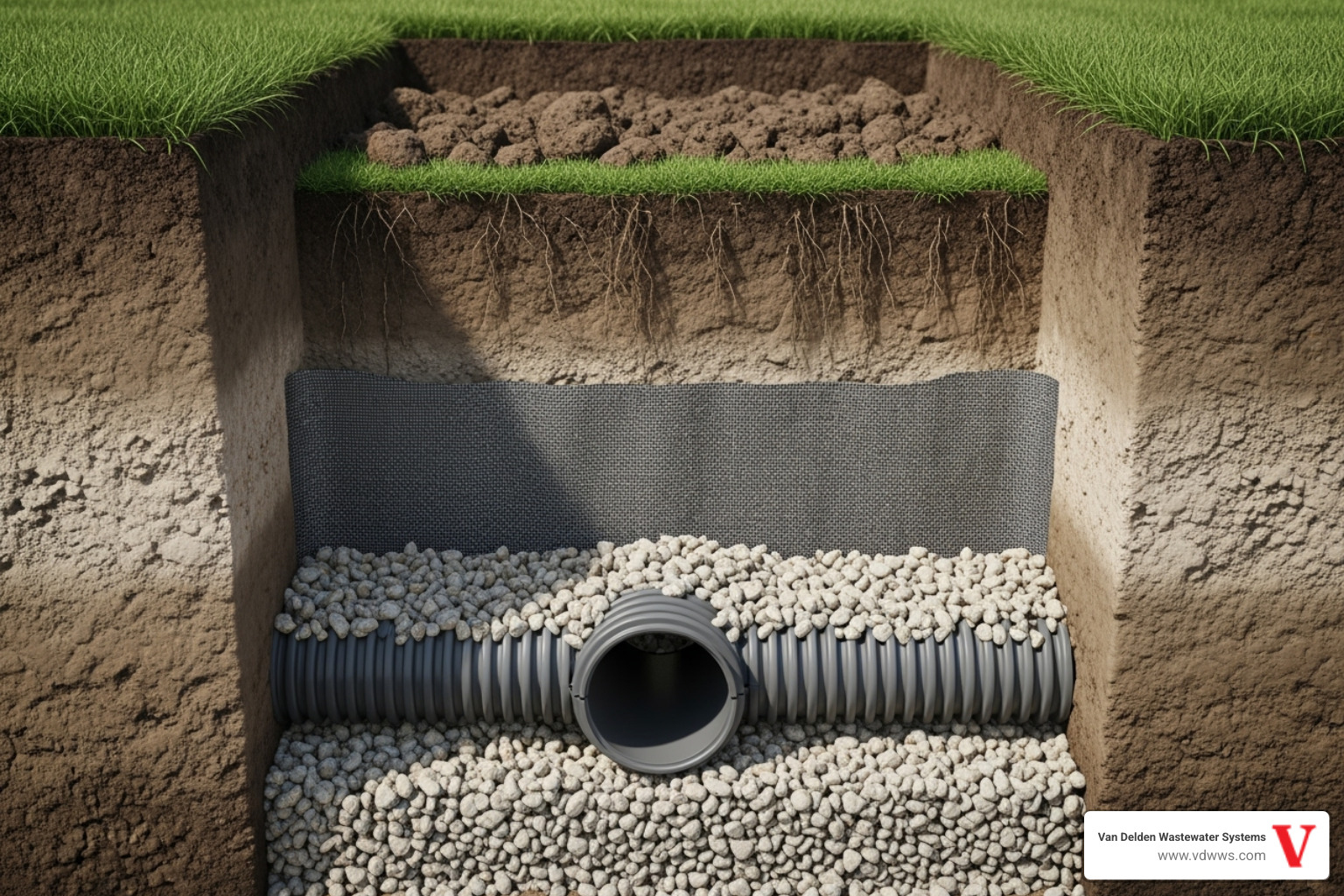
A conventional system consists of gravel-filled trenches containing perforated PVC pipes. The pipes are laid at a slight slope to allow gravity to move the effluent. The gravel provides filtration and even distribution. The trenches are covered with a geotextile fabric and then backfilled with soil. A distribution box (D-box) ensures that effluent from the septic tank is divided evenly among all the field lines, preventing any single line from being overworked.
System Design Considerations
Designing effective septic system field lines requires careful engineering. Key considerations include:
- Soil Suitability: We analyze soil texture and percolation rates to ensure the soil can properly absorb and treat wastewater.
- Drainfield Sizing: The system must be sized correctly based on soil type and the home's estimated daily wastewater volume (typically based on the number of bedrooms).
- Setbacks and Clearances: Field lines must be installed at specific distances from wells, water bodies, property lines, and buildings to comply with local regulations and protect public health.
- Site Constraints: Challenges like shallow soil, high water tables, or bedrock require specialized designs. We have extensive experience with these issues, including High Water Tables Impact on Drainfields.
- Reserve Area: Many regulations require a designated backup area for a future replacement drain field if the primary one fails.
Signs of Failure and Essential Maintenance for Your Septic System Field Lines
When septic system field lines fail, the signs are hard to ignore, and the consequences can include costly repairs, health hazards, and property damage. Early detection is key to preventing major headaches. Homeowners who catch problems early almost always save money and stress. For issues common in our area, see our guide on Signs of Drainfield Problems in San Antonio Home.
How to Identify Failing Septic System Field Lines
Your property will give you clues when your septic system field lines are in trouble. Be on the lookout for these warning signs:
- Sewage odors near the drain field area.
- Wet, soggy spots or standing water over the field lines.
- Unusually lush, green grass growing only above the field lines.
- Slow-draining sinks, showers, and toilets inside your home.
- Gurgling sounds from your drains.
- Contaminated well water, indicated by tests showing bacteria or high nitrate levels.
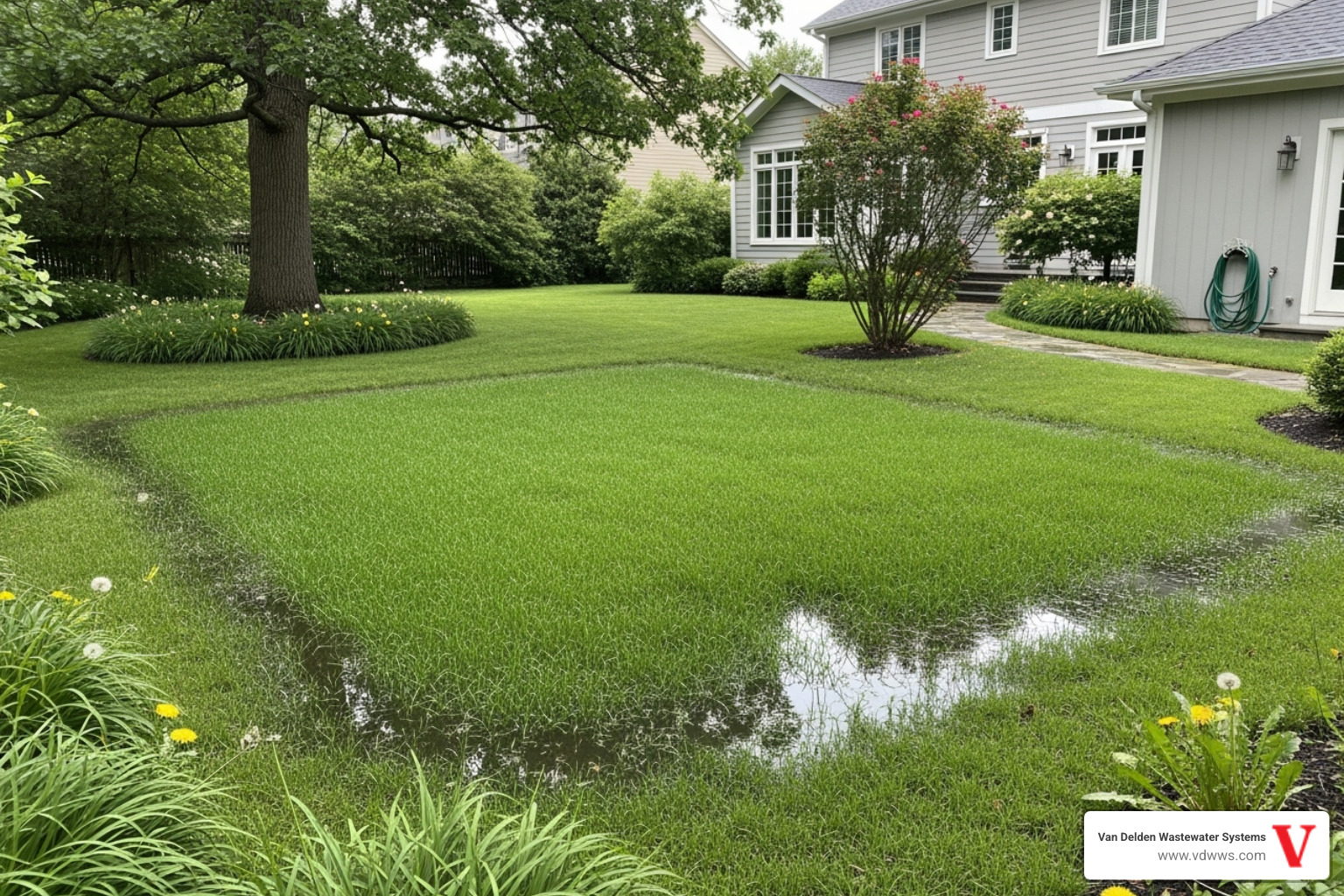
If you notice any of these signs, act quickly. Our guide to Common Septic Drainfield Problems provides more detail.
Essential Maintenance for Healthy Septic System Field Lines
Proactive maintenance is the best way to protect your investment and ensure the longevity of your septic system field lines.
- Regular Septic Tank Pumping: Have your tank inspected and pumped every 3-5 years to remove solids before they can clog your field lines.
- Effluent Filter Cleaning: If your system has one, clean it annually to prevent solids from reaching the drainfield.
- Water Conservation: Reduce water usage to avoid overloading the system. Spread out laundry loads and fix leaks. Learn more about How Excessive Water Use Affects Drainfield.
- Protect the Drainfield Area: Never park vehicles or build structures over the field lines. Plant only grass, as tree roots can damage pipes.
- Manage Surface Water: Direct rainwater from gutters and downspouts away from the drain field to prevent soil saturation.
For more tips, see our guide on Extending the Life of Your Drainfield.
What Not to Flush or Pour Down the Drain
The health of your septic system field lines depends on the bacteria in your tank. Avoid sending down anything that can harm them or cause clogs:
- Grease, fats, and oils: They solidify and cause clogs.
- Harsh chemicals: Drain cleaners and excessive bleach kill beneficial bacteria.
- "Flushable" wipes, paper towels, and feminine hygiene products: They don't break down and will clog the system.
- Paint, solvents, and pharmaceuticals: They are toxic to the system and the environment.
- Garbage disposals: They add excessive solids to the tank. Compost food scraps instead.
- Septic additives: Most are unnecessary and can even harm your system.
Environmental Impact and System Lifespan
Properly functioning septic system field lines are environmental guardians, cleaning wastewater before it rejoins the natural water cycle. When they fail, the consequences can be severe, affecting groundwater, local streams, and ecosystems.
Environmental Implications: Functioning vs. Failing Systems
A healthy septic system protects public health and the environment. It removes harmful bacteria and viruses, preventing contamination of groundwater that supplies wells. It also keeps pollutants out of surface waters like creeks and rivers.
When septic system field lines fail, this protection is lost.
- Groundwater Contamination: Untreated wastewater containing pathogens like E. coli can seep into drinking water sources.
- Surface Water Pollution: Effluent can surface in your yard and flow into nearby ditches and streams.
- Nutrient Pollution: Excess nitrogen and phosphorus from wastewater can cause harmful algae blooms in lakes and ponds, killing fish and disrupting aquatic life. You can see how pollution can harm delicate ecosystems in this video.
Proper maintenance prevents these environmental issues. As we explain in our article, Poor Drainfield Maintenance Affects Your Property, the effects extend far beyond your yard.
Lifespan of Leach Lines and Influencing Factors
A common question is, "How long will my septic system field lines last?" With proper care, a system can last 15 to 40 years, and sometimes longer. The actual lifespan depends on several factors:
- Soil Type: Ideal loamy soils support a longer lifespan than heavy clay or overly sandy soils.
- System Design and Installation: A properly sized and professionally installed system has a significant advantage.
- Maintenance Frequency: This is the most critical factor. Regular pumping and inspections can double a system's life.
- Household Habits: Water conservation and being careful about what goes down the drain make a huge difference.
- External Factors: Tree root intrusion and physical damage from vehicles can shorten a system's life.
With proactive care, your system can serve your family for decades. Our services, like Drainfield Cleaning for Septic System Maintenance, are designed to maximize your system's lifespan.
Frequently Asked Questions about Septic Drainfields
Here are answers to some of the most common questions we receive about septic system field lines from homeowners across Texas.
How long do septic field lines typically last?
Septic system field lines typically last 15 to 40 years. The exact lifespan depends heavily on factors like soil type, the quality of the original installation, household water usage, and, most importantly, maintenance. Regular septic tank pumping and proper care can help your system reach or even exceed the upper end of that range, while neglect can lead to failure in as little as 10-15 years.
How do septic system field lines differ from a municipal sewer system?
The main difference is responsibility and location. With a municipal sewer, you pay a monthly bill for a centralized plant to treat your wastewater. With septic system field lines, you are responsible for your own onsite treatment system located in your yard. Septic systems use natural soil processes for treatment, whereas municipal plants use complex mechanical and chemical methods. This gives homeowners in rural areas independence from public utilities.
Can you repair just one part of a leach field?
Sometimes, yes. A repair is often possible for localized issues like a single crushed pipe or a clog near the distribution box. In these cases, we can excavate and fix the specific problem area. However, if the failure is due to widespread issues like system-wide biomat clogging or old age, a partial repair won't solve the underlying problem. The entire drain field may need to be replaced. Professional diagnosis is absolutely key to determine the correct course of action. Our experienced technicians can assess the entire system and provide an honest evaluation of whether a targeted repair is sufficient or if a more comprehensive solution is needed.
Conclusion
Your septic system field lines are the unsung heroes of your property, quietly protecting your family's health and the environment. Understanding how they work and how to care for them is essential for any homeowner with a septic system.
By using natural soil processes, your field lines transform wastewater into clean water. The longevity of this system is in your hands. Regular maintenance, including septic tank pumping every 3-5 years and being mindful of what goes down your drains, can mean the difference between a system that lasts 15 years and one that serves you for 40 or more.
Properly maintaining your septic system field lines is also an act of environmental stewardship, protecting our shared groundwater and local waterways.
At Van Delden Wastewater Systems, we've helped Texas families with their septic systems since 1937. Our family-owned business is built on trust and education. Our background-checked, non-commissioned technicians provide honest advice that is always in your best interest.
Don't wait for soggy spots or slow drains to become major problems. The sooner you address an issue, the easier and less costly the solution will be. Your septic system field lines protect your family—return the favor with proper care. For professional maintenance and honest advice, we're here to help.
Customer Reviews
Peter was personable, professional and thorough. Highly recommend Van Delden. You might be able to find a cheaper company but not better!
On time. 100% professional, knowledgeable, and courteous. Very helpful and straightforward. That is the bar all businesses should strive for.
It has been a pleasure working with your company. Not only did y’all communicate very well but your workers were always polite! Thank you!
“I thank Van Delden for such prompt service. Honest people are hard to come by these days. I will certainly recommend Van Delden to anyone! Jesse is an upstanding young man and very nice to talk to. I thank everyone at Van Delden for taking such good care of me.”
This is just a note to thank you for explaining the problem with my system. You didn’t have to be so kind and I appreciate your good business ethics and time spent. In the future you will have mine in return!



